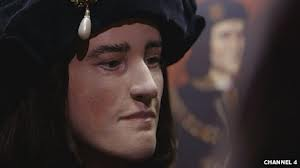
Richard III facial reconstruction based on the skull found under a car park in Leicester has revealed how the English king may have looked.
The skeleton found in Leicester has been confirmed as that of the king.
The reconstructed face has a slightly arched nose and prominent chin, similar to features shown in portraits of Richard III painted after his death.
Historian and author John Ashdown-Hill said seeing it was “almost like being face to face with a real person”.
The development comes after archaeologists from the University of Leicester confirmed the skeleton found last year was the 15th Century king’s, with DNA from the bones having matched that of descendants of the monarch’s family.
Richard III was killed in the Battle of Bosworth in 1485, at the age of 32 and after just two years on the throne, having been challenged by the forces of Henry Tudor, the future Henry VII.
Dr. John Ashdown-Hill, who wrote The Last Days of Richard III, said: “The most obvious features in portraits are the shape of the nose and the chin and both of those are visible in the facial reconstruction.”
Richard III Society member Philippa Langley, originator of the search, said on a Channel 4 documentary earlier: “It doesn’t look like the face of a tyrant. I’m sorry but it doesn’t.
“He’s very handsome. It’s like you could just talk to him, have a conversation with him right now.”
Layers of muscle and skin were added by computer to a scan of the skull and the result was made into a three-dimensional plastic model.

Dr. John Ashdown-Hill said: “I had said previously that when I stood by the grave in Leicester that I felt closer to Richard III than I had ever been, but when I saw the facial reconstruction I realised I had been close to a dead Richard III.
“It was just bones, just a body, whereas confronting a facial reconstruction, I felt almost in the presence of a living Richard III.”
The facial reconstruction is particularly important because there are no surviving contemporary portraits of Richard III.
Dr. John Ashdown-Hill said: “All the surviving portraits of him – even the very later ones with humped backs and things which were obviously later additions – facially are quite similar [to each other] so it has always been assumed that they were based on a contemporary portrait painted in his lifetime or possibly several portraits painted in his lifetime.”
The Richard III society will officially unveil the reconstruction at 10:00 GMT on Tuesday, at the Society of Antiquaries in London.
It is expected that the reconstruction will be put on public display in future.
Experts from the University of Leicester said DNA from the skeleton matches that of a descendant of Richard III’s family.
Dr. John Ashdown-Hill said: “We weren’t certain whether the body was Richard III so the facial reconstruction – particularly if it hadn’t been possible to get DNA from the bones – might have been an additional piece of evidence, and still is.”
Caroline Wilkinson, professor of craniofacial identification at the University of Dundee, said: “When the 3D digital bust was complete it was replicated in plastic using a rapid prototyping system and this was painted, prosthetic eyes added and dressed with a wig, hat and clothing.”
Prof. Caroline Wilkinson said the Dundee team artist, Janice Aitken, used the portraits of Richard III at this stage as reference for hair style and color, eye color, skin color and clothing.
“These details are not known from the skeletal remains and are estimated based on the most likely appearance from this period of time,” she said.
[youtube GHXfBN9-NDI]
[youtube IAm42FsH4R4]